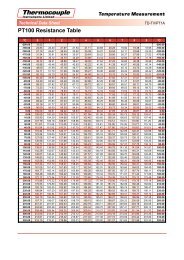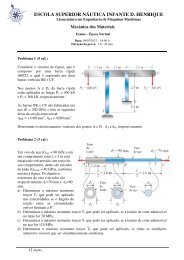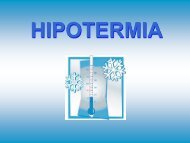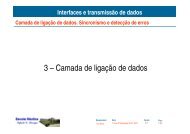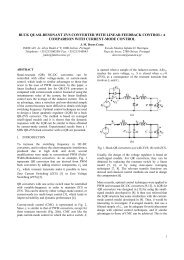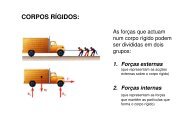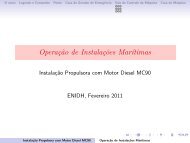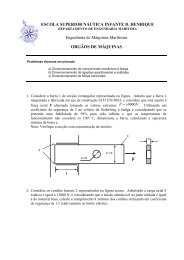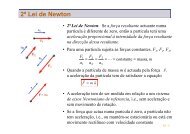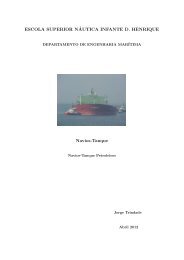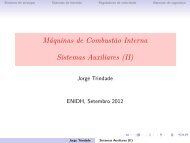Textos de Apoio (pdf)
Textos de Apoio (pdf)
Textos de Apoio (pdf)
You also want an ePaper? Increase the reach of your titles
YUMPU automatically turns print PDFs into web optimized ePapers that Google loves.
ITTC – Recommen<strong>de</strong>d<br />
7.5-04<br />
-01-01.1<br />
Procedures and Gui<strong>de</strong>lines Page 6 of 10<br />
Full Scale Measurements<br />
Speed and Power Trials<br />
Preparation and Conduct of<br />
Speed/Power Trials<br />
Effective Date<br />
2005<br />
Revision<br />
03<br />
The bias limits of the instrumentation used<br />
for the measurements should be known and assessed.<br />
The instrumentation used for the on-boardmeasurements<br />
must be calibrated before application<br />
on board. If this is not possible, for some<br />
reason, the consequences of this should be<br />
highlighted in the final trial report. Electrical<br />
calibration is recommen<strong>de</strong>d for the torque<br />
measurement <strong>de</strong>vice and, in case of use during<br />
the sea trials, for the thrust measurement <strong>de</strong>vice.<br />
Further a calibration should be done for the<br />
pick ups and the respective amplifiers used for<br />
the measurement of the rate of revolutions. A<br />
“calibration” of a (differential) GPS-System is<br />
not possible without excessive measures, but at<br />
least the function of the <strong>de</strong>vice should be<br />
checked before use on board.<br />
If portable radar tracking or (differential)<br />
GPS is utilized, a Receiver/Transmitter (R/T)<br />
unit or GPS antenna is to be installed. In case<br />
the soft ware program used for the evaluation<br />
of the data received does not allow for varying<br />
positions on the uppermost <strong>de</strong>ck of the ship the<br />
antenna should be placed in a location along<br />
the ship’s centerline as close to the ship’s CG<br />
as possible. This location will i<strong>de</strong>ally be located<br />
on a mast or site that is clear of obstructions,<br />
such as the ship’s superstructure.<br />
4.4.2 Instrumentation Calibration Check<br />
All shipboard signals to be recor<strong>de</strong>d during<br />
the trials must be adjusted to zero or should<br />
have their zero value checked (e.g. for a (D)<br />
GPS-<strong>de</strong>vice) after the instrumentation installation<br />
is completed and prior to the trials. The<br />
zero values of the torsiometers, the thrust<br />
measurement <strong>de</strong>vices and the <strong>de</strong>vices for the<br />
measurement of the rates of revolutions must<br />
be checked before the trial runs start and after<br />
they have been finished.<br />
As part of the pre-trial calibration, the torsion<br />
meters zero torque readings must be <strong>de</strong>termined<br />
since there is a residual torque in the<br />
shaft, which is resting on the line shaft bearings.<br />
This might be done in different ways; one possible<br />
way is to use the jacking motors. The<br />
shaft is jacked both ahead and astern and the<br />
average of the readings noted. The zeroes are<br />
set at the midpoint of the torque required to<br />
jack each shaft ahead and the torque required to<br />
jack each shaft astern. An allowance is normally<br />
ma<strong>de</strong> for frictional losses in the stern<br />
tube bearings.<br />
As part of the pre-trial calibration for a ship<br />
equipped with controllable pitch propellers,<br />
maximum ahead pitch, the <strong>de</strong>sign pitch and the<br />
maximum astern pitch should be <strong>de</strong>termined<br />
and then the ship indicators should be adjusted<br />
to reflect the measurement.<br />
4.5 Trial Conditions<br />
Speed/Power trials require accurate position<br />
data. The use of (D) GPS provi<strong>de</strong>s great latitu<strong>de</strong><br />
in choosing a trial site. Regardless of the<br />
instrumentation utilized for obtaining positional<br />
data, the operational area should be free<br />
from substantial small boat traffic.<br />
The tracking range should be agreed between<br />
the Trial Director and the ship’s master.<br />
Draft, trim and displacement of the ship on<br />
trials should be obtained by averaging the ship<br />
draft mark readings. The ship should be<br />
brought into a condition that is as close as possible<br />
to the contract condition and/or the condi-



![Conceitos transmissao de dados .Sinais[.pdf]](https://img.yumpu.com/50982145/1/190x146/conceitos-transmissao-de-dados-sinaispdf.jpg?quality=85)
![Packages e interfaces[.pdf]](https://img.yumpu.com/50629553/1/190x134/packages-e-interfacespdf.jpg?quality=85)
